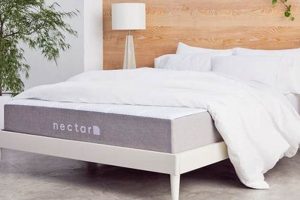A standard “full” size mattress, sometimes referred to as a double mattress, measures approximately 54 inches in width and 75 inches in length. This provides a sleeping surface suitable for a single adult or, in some cases, two smaller individuals. The dimensions offer a middle ground between a twin and a queen size bed.
The utility of this particular mattress dimension lies in its efficient use of space. It provides more sleeping area than a twin bed, making it comfortable for individuals who prefer more room to stretch out. Historically, it has served as a common choice for guest rooms, children transitioning from smaller beds, and smaller apartments where space is a premium.
The following sections will delve deeper into comparing this specific mattress size with others, exploring its suitability for different sleeping arrangements, and outlining factors to consider when purchasing a mattress of this particular dimension.
Considerations for Selecting a Mattress of Specific Dimensions
The following points outline crucial aspects to consider when evaluating a mattress with the measurements of a standard “full” size. Careful consideration of these aspects ensures an informed purchase decision.
Tip 1: Room Size Assessment: Prior to purchase, accurately measure the intended bedroom space. This mattress size, while more compact than larger options, still requires adequate clearance to allow for movement and furniture placement within the room.
Tip 2: Occupancy Requirements: Evaluate the typical number of sleepers. While it can accommodate two individuals, the reduced sleeping surface per person may compromise comfort for extended co-sleeping. Single occupancy is generally the most suitable use case.
Tip 3: Frame Compatibility Verification: Confirm the bed frame is explicitly designed to support the measurements of a “full” size mattress. An improperly sized frame can lead to premature mattress wear or structural instability.
Tip 4: Sheet Set Standardization: “Full” size mattress dimensions are a common standard. Therefore, finding fitted sheets and bedding accessories designed specifically for this size should present no significant difficulty.
Tip 5: Body Type Considerations: Individuals with larger builds or those who prefer ample space while sleeping may find this mattress size restrictive. A larger mattress, such as a queen or king, may be a more appropriate choice.
Tip 6: Intended Use Frequency: Consider how often the mattress will be used. For guest rooms with infrequent occupancy, a “full” size offers a reasonable balance of comfort and space efficiency. For daily use by a single individual, its suitability depends on personal preferences and body size.
By carefully considering these factors, one can determine whether a mattress of this specified size aligns with their individual needs and space constraints, leading to a more satisfactory purchase.
The subsequent sections will explore the specific advantages and disadvantages associated with choosing this mattress size over alternative options, providing a more nuanced understanding of its applicability in various scenarios.
1. Width (54 inches)
The width measurement of 54 inches constitutes a defining characteristic of a standard “full” size mattress. This dimension directly influences the comfort level and suitability of the mattress for specific individuals or sleeping arrangements. Its implications extend beyond simple measurement, affecting room layout and the overall sleeping experience.
- Single Sleeper Comfort
A 54-inch width provides ample space for a single adult sleeper to move freely during the night without feeling confined. This is particularly beneficial for individuals who tend to toss and turn or prefer to sprawl out while sleeping. The increased width compared to a twin mattress translates to a significantly enhanced sense of personal space.
- Co-Sleeping Considerations
While technically capable of accommodating two adults, the 54-inch width results in only 27 inches of personal space per sleeper. This is substantially less than a queen or king-size mattress, potentially leading to discomfort and disrupted sleep for both individuals, especially if either sleeper is restless or has a larger build. Co-sleeping is generally not recommended for extended periods on a mattress of this width.
- Room Space Optimization
The 54-inch width offers a compromise between sleeping comfort and efficient space utilization. It occupies less floor space than larger mattresses, making it a viable option for smaller bedrooms or guest rooms where square footage is limited. This dimension allows for a functional sleeping area without overwhelming the room’s overall layout.
- Bedding and Frame Compatibility
This dimension is a recognized standard. Therefore, bed frames and fitted sheets tailored to “full” or “double” mattresses are widely available. The standardized width simplifies the process of sourcing compatible accessories and ensures a proper fit, preventing issues such as sheet slippage or an unstable mattress platform.
In summary, the 54-inch width inherent to the “full” size mattress dictates its suitability for specific uses. While offering comfortable sleeping space for a single individual and optimizing room space, its limitations regarding co-sleeping must be carefully considered. The standardized nature of this width ensures ease of finding compatible bedding and frames, simplifying the purchasing process.
2. Length (75 inches)
The 75-inch length is a defining characteristic of a standard “full” size mattress, directly impacting its suitability for individuals of varying heights. Understanding this dimension is crucial for ensuring comfortable and restful sleep. Its effect extends beyond simple physical accommodation, influencing sleep posture and overall spinal alignment.
- Height Accommodation
The 75-inch length is generally adequate for individuals up to approximately 5’10” (70 inches) in height. Exceeding this height may result in feet hanging off the end of the mattress, leading to discomfort and disrupted sleep. Individuals taller than this threshold should consider mattresses with greater length, such as queen or king sizes.
- Sleeping Posture and Alignment
Sufficient mattress length allows for proper spinal alignment and reduces the likelihood of adopting cramped or unnatural sleeping positions. This is particularly important for individuals with back pain or other musculoskeletal conditions. A mattress that is too short can force the body into compensatory postures, exacerbating existing problems.
- Relationship to Width
The 75-inch length, in conjunction with the 54-inch width, defines the overall rectangular sleeping surface. This aspect ratio influences the sense of spaciousness and freedom of movement available to the sleeper. Maintaining a proper balance between length and width is crucial for optimizing comfort.
- Bedding and Frame Compatibility
As with the width, the 75-inch length is a standardized dimension. This ensures that fitted sheets, mattress protectors, and bed frames designated for “full” or “double” size mattresses will provide a proper fit. Standardization simplifies the process of purchasing compatible bedding accessories and eliminates the need for custom-made items.
The 75-inch length, therefore, plays a critical role in determining the suitability of a mattress for a given individual. By considering height, sleeping posture, and the relationship between length and width, prospective buyers can make informed decisions that prioritize comfort and promote restful sleep. Choosing the incorrect length can lead to long-term discomfort and potential health issues, highlighting the importance of careful evaluation.
3. Surface Area (4050 sq in)
The surface area, calculated at 4050 square inches, represents the total sleeping space provided by a standard “full” size mattress. This figure is derived directly from its dimensions a width of 54 inches multiplied by a length of 75 inches. The quantifiable nature of surface area allows for objective comparison against other mattress sizes, revealing the inherent trade-offs between space occupancy and individual sleeper comfort. For instance, a twin XL mattress offers a comparable length but significantly less width and, consequently, a reduced surface area. This directly impacts the ability to comfortably move or change sleeping positions during the night. Conversely, a queen mattress provides a substantially larger surface area, affording greater individual sleeping space or accommodating two sleepers more comfortably.
The practical significance of understanding the surface area lies in its direct correlation to sleep quality. Limited surface area can lead to restricted movement, disrupted sleep cycles, and even feelings of confinement, particularly for individuals accustomed to more spacious sleeping arrangements. Real-world examples include individuals transitioning from a larger mattress to a “full” size in a smaller living space. Without acknowledging the reduced surface area, they may experience dissatisfaction and decreased sleep quality. Conversely, for individuals transitioning from a smaller twin mattress, the increased surface area of a “full” size can represent a significant improvement in sleeping comfort.
In summary, the 4050 square inch surface area is an inherent characteristic of a mattress measuring 54 inches by 75 inches, profoundly influencing its suitability for diverse sleeping needs and space constraints. The surface area metric facilitates objective comparisons and assists in making informed purchase decisions aligned with individual preferences and real-world limitations. Its importance stems from its direct impact on sleep quality and overall user satisfaction.
4. Space Efficiency
Space efficiency, in the context of mattress selection, refers to the ratio of sleeping surface area to the overall footprint of the bed. When considering “how big full size mattress” dimensions, its space efficiency becomes a key factor, particularly in smaller living spaces.
- Bedroom Square Footage Optimization
A full-size mattress occupies less square footage compared to queen or king-size options, allowing for more efficient utilization of bedroom space. This is particularly relevant in apartments, smaller homes, or guest rooms where available space is limited. The dimensions of the full-size mattress allow for more maneuverability within the room, leaving space for other essential furniture items.
- Dormitory and Small Apartment Suitability
The dimensions of a full-size mattress often align well with the limited space available in dormitories or small apartments. It offers a comfortable sleeping surface for a single individual without overwhelming the room. Larger mattress sizes may not be practical due to space constraints, making the full-size a viable and efficient choice.
- Multi-Purpose Room Considerations
In rooms serving multiple functions, such as a home office or a guest room that also functions as a living area, the space efficiency of a full-size mattress becomes critical. It allows for a sleeping area without significantly compromising the room’s primary function. Foldaway beds or futons are alternatives, but a dedicated mattress of appropriate dimensions offers superior comfort for regular use. This addresses the need for a hybrid room to facilitate various activities.
- Minimalist Living Spaces
In spaces designed around minimalist principles, maximizing efficiency is paramount. Full size mattresses provide a balance between comfort and utilization of space. The reduced footprint compared to other larger options like queen or king provides minimalist interiors with a functional sleeping area whilst retaining space and maintaining the aesthetic of minimalism.
The space efficiency of a full-size mattress makes it a suitable option for individuals seeking a balance between sleeping comfort and maximizing available living space. By carefully considering room dimensions and usage patterns, one can determine whether the full-size mattress offers the optimal solution in a space-constrained environment.
5. Sleep Capacity
The sleep capacity of a “full” size mattress, directly related to its dimensions, dictates the number of individuals it can comfortably accommodate. The 54-inch width and 75-inch length typically provide adequate space for a single adult sleeper. Attempting to accommodate two adults on a regular basis can lead to compromised sleep quality for both individuals due to restricted space and potential disturbances. For example, couples who frequently share a “full” size mattress may experience increased restlessness, reduced individual sleep duration, and potential discomfort arising from limited personal space. The correlation between mattress size and sleep quality is particularly pronounced in cases where one or both sleepers are restless or have larger body builds.
The practical significance of understanding sleep capacity extends to decisions regarding guest room furnishings. A “full” size mattress offers a reasonable compromise between space efficiency and guest comfort for short-term stays. However, for guest rooms intended to accommodate couples, a larger mattress, such as a queen or king, is preferable to ensure adequate sleep capacity. Similarly, parents transitioning children from smaller beds should consider the long-term implications of sleep capacity. While a “full” size mattress may initially suffice, teenagers or young adults may eventually require a larger mattress to accommodate their growth and changing sleep needs. Conversely, a larger individual may find that they require a larger sleep space for long-term comfort. This highlights the critical role of matching sleep capacity to the intended user demographics and frequency of use.
In summary, the sleep capacity of a “full” size mattress is intrinsically linked to its physical dimensions. While suitable for single sleepers, its limitations regarding co-sleeping should be carefully considered. Overlooking sleep capacity can result in compromised sleep quality, highlighting the importance of aligning mattress size with individual needs and usage patterns. Understanding the connection between sleep capacity and “how big full size mattress” is crucial for making informed decisions that prioritize comfort and promote restful sleep within practical space constraints.
6. Frame Compatibility
Frame compatibility is a critical component of successfully utilizing a mattress of specific dimensions. A full-size mattress, measuring 54 inches by 75 inches, necessitates a frame engineered to provide adequate support. A mismatch between the mattress size and the frame can lead to several adverse consequences. For instance, an undersized frame will fail to adequately support the mattress, causing sagging and premature wear. This, in turn, reduces the comfort and lifespan of the mattress itself. Conversely, an oversized frame can allow the mattress to shift excessively, creating instability and potential safety hazards. Proper frame compatibility ensures even weight distribution, preserving the structural integrity of the mattress and maximizing its usable lifespan.
Real-world examples underscore the importance of frame compatibility. Consider a scenario where an individual purchases a full-size mattress but uses an old frame originally designed for a smaller twin mattress. The overhang of the mattress will place undue stress on the unsupported edges, leading to localized compression and eventual breakdown of the mattress materials. Alternatively, if a full-size mattress is placed on a queen-size frame, the resulting gap can create a tripping hazard and compromise the overall stability of the bed. Therefore, verifying the frame’s compatibility with the exact dimensions of the mattress is an essential step in the purchasing process. This verification should include confirming that the frame is explicitly labeled as suitable for a “full” or “double” size mattress and that its internal dimensions closely match the mattress measurements.
In summary, achieving proper frame compatibility is indispensable for ensuring the longevity, comfort, and safety of a full-size mattress. Neglecting this aspect can lead to premature mattress wear, structural instability, and potential safety hazards. By carefully selecting a frame specifically designed to support a full-size mattress and verifying its dimensions, individuals can optimize their sleep experience and protect their investment in quality bedding. Prioritizing frame compatibility is not merely a suggestion, but rather a fundamental requirement for the effective utilization of any mattress of specified dimensions.
Frequently Asked Questions Regarding Mattress Dimensions
The following section addresses common inquiries and misconceptions pertaining to a particular mattress size, providing detailed information to guide informed decision-making.
Question 1: What constitutes the precise dimensions of a standard “full” size mattress?
A standard “full” size mattress measures approximately 54 inches in width and 75 inches in length. Variations of up to one inch may occur depending on manufacturing tolerances and specific mattress construction.
Question 2: Is this particular mattress size appropriate for accommodating two adult sleepers?
While technically capable of accommodating two adults, the reduced sleeping surface per person may compromise comfort for extended co-sleeping. Single occupancy is generally considered the most suitable use case.
Question 3: What are the primary advantages of selecting a mattress of this specific dimension?
The key advantages include efficient use of space, adequate sleeping area for a single adult, and widespread availability of compatible bedding accessories.
Question 4: How does the cost of a “full” size mattress compare to that of other mattress sizes?
Generally, a “full” size mattress is less expensive than queen or king-size mattresses, but more expensive than twin or twin XL mattresses. Pricing varies based on materials, construction, and brand.
Question 5: What factors should be considered when selecting a bed frame for a mattress of this specific dimension?
The bed frame must be explicitly designed to support the dimensions of a “full” size mattress. An improperly sized frame can lead to premature mattress wear or structural instability. The interior dimensions of the frame should closely match the mattress measurements.
Question 6: Are fitted sheets readily available for mattresses of this dimension?
Yes, fitted sheets and bedding accessories designed specifically for the “full” size mattress are widely available from various retailers.
In summary, a “full” size mattress offers a balance between space efficiency, sleeping comfort, and affordability. However, careful consideration of occupancy requirements and individual preferences is crucial for making an informed purchase decision.
The next section will explore the suitability of this mattress size for specific user demographics and room types, providing further guidance for prospective buyers.
Understanding Mattress Dimensions
The exploration of “how big full size mattress” has revealed its defining characteristics and suitability for specific applications. The dimensions of 54 inches in width and 75 inches in length offer a compromise between space efficiency and individual comfort. While accommodating a single adult sleeper adequately, co-sleeping may present challenges due to restricted personal space. Frame compatibility remains paramount, requiring a properly sized and supportive structure to prevent premature wear and ensure stability. These considerations are fundamental to making an informed purchase decision aligned with individual needs and spatial constraints.
The significance of understanding mattress dimensions extends beyond mere numerical values. It encompasses the practical implications for sleep quality, room layout, and long-term user satisfaction. As sleeping arrangements evolve and living spaces adapt, a thorough assessment of mattress size relative to personal requirements remains essential. Continued awareness of these factors will contribute to a more informed and optimized approach to selecting bedding that promotes restful sleep and overall well-being.



![Buy Wayfair Full Mattress Now! [Deals!] Organic & Natural Mattress Buyer’s Guide: Non-Toxic Sleep Solutions Buy Wayfair Full Mattress Now! [Deals!] | Organic & Natural Mattress Buyer’s Guide: Non-Toxic Sleep Solutions](https://mattressworldpa.com/wp-content/uploads/2025/07/th-2820-300x200.jpg)



